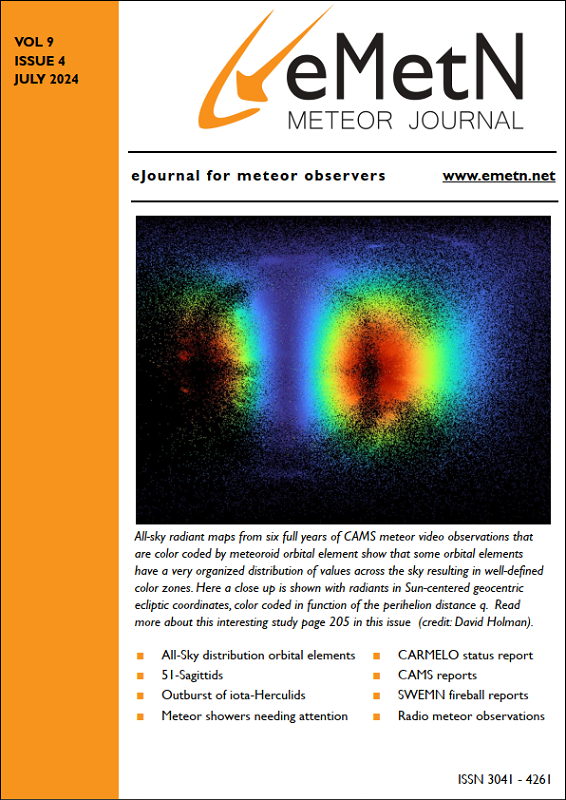Abstract: The meteor activity in September has been observed by radio meteor observers worldwide. Aurigids (AUR#206) and September ε-Perseids (SPE#208) showed very weak activities. At the end of September, some increased activity has been observed according to the monthly report from Japan.
1. Introduction
Radio meteor observations in the world covered the meteor shower activity of the Aurigids and the ε-Perseids 2020. Worldwide radio meteor observation data were provided by Radio Meteor Observation Bulletin (RMOB) (Steyaert, 1993) and by the radio meteor observations network in Japan (Ogawa et al., 2001).
2. Method
For analyzing worldwide radio meteor observation data, meteor activities are calculated by the “Activity Level” index (Ogawa et al., 2001). The activity profile was estimated by the Lorentz activity profile (Jenniskens, 2000).
3. Results
3.1. Aurigids (AUR#206)
Figure 1 shows the result for the Aurigids with 34 observations from 13 countries. Although the peak position is expected around Solar Longitude λʘ = 158.6°, no unusual activity has been observed during this year. Figure 2 shows the estimated ZHR using radio meteor observation data by Hirofumi Sugimoto (Sugimoto, 2017).

Figure 1 – Aurigids 2020 using worldwide radio meteor observations.

Figure 2 – Estimated ZHR by radio meteor observations (provided by Hirofumi Sugimoto).
3.2. September ε-Perseids (SPE#208)
No clear activity from the September ε-Perseids could be found by using 34 observations from 13 countries (Figure 3 and Figure 4). It showed very weak activity, about less than an activity level of 0.5. The estimated ZHR provided by Hirofumi Sugimoto also shows a weak activity level.

Figure 3 – September ε-Perseids 2020 using worldwide radio meteor observations.

Figure 4 – Estimated ZHR by radio meteor observations (provided by Hirofumi Sugimoto).
3.3. The monthly report in September from Japanese radio observers
Figure 5 shows the monitored result in September by using the data from Japanese radio meteor observers. Although there was no clear high activity, a little increase can be seen around the end of September. This is possible due to one of the daytime meteor showers, the Daytime Sextantids (DSX#221). I intend to analyze the DSX#221 activity including the October reports.

Figure 5 – Monthly report for September 2020 (only Japanese observing stations).
Acknowledgment
The Aurigids (Figure 1) and September ε-Perseids data (Figure 3) were provided by the following observers:
Chris Steyaert (Belgium), Felix Verbelen (Belgium), Daniel D SAT01_DD (France), Jacques Molne (France), Jean Marie F5CMQ (France), Pierre Micaletti (France), Fred Espey (Germany), Per DL0SHF (Germany), WHS Essen (Germany), Balogh Laszlo (Hungary), AAV Planetario_di_Venezia (Italy), Associazione Pontina di Astronomia _APA_ (Italy), Fabio Moschini_IN3GOO (Italy), GAML Osservatorio_Astronomico_Gorga (Italy), Mario Bombardini (Italy), Oss_Monte_San_Lorenzo DLF (Italy), Kenji Fujito (Japan), Hirofumi Sugimoto (Japan), Hironobu Shida (Japan), Hirotaka Otsuka (Japan), Masaki Kano (Japan), Masaki Tsuboi (Japan), Tomohiro Nakamura (Japan), Salvador Aguirre (Mexico), Kees Meteor (Netherlands), RondaRonda (Spain), Jochen Richert (Switzerland), Ian Evans (UK), Philip Norton (UK), Eric Smestad_KC0RDD (USA), Mike Otte (USA), Stan Nelson (USA).
The worldwide data were provided by the Radio Meteor Observation Bulletin (RMOB) (http://www.rmob.org/).
Figure 2 and Figure 4 were provided by Hirofumi Sugimoto.
Figure 5 was provided by Hirofumi Sugimoto, Masaki Tsuboi, Kenji Fujito, Hirotaka Otsuka, Tomohiro Nakamura and Hironobu Shida.
References
Jenniskens P., Crawford C., Butow S. J., Nugent D., Koop M., Holman D., Houston J., Jobse K., Kronk G., and Beatty K. (2000). “Lorentz shaped comet dust trail cross section from new hybrid visual and video meteor counting technique imprications for future Leonid storm encounters”. Earth, Moon and Planets, 82–83, 191–208.
Ogawa H., Toyomasu S., Ohnishi K., and Maegawa K. (2001). “The Global Monitor of Meteor Streams by Radio Meteor Observation all over the world”. In, Warmbein Barbara, editor, Proceeding of the Meteoroids 2001 Conference, 6-10 August 2001, Swedish Institute of Space Physics, Kiruna, Sweden. ESA Publications Division, European Space Agency, Noordwijk, The Netherlands,
pages 189–191.
Ogawa H., Steyaert C. (2017). “Major and Daytime Meteor Showers using Global Radio Meteor Observations covering the period 2001-2016”. WGN, Journal of the IMO, 45, 98–106.
Sugimoto H. (2017). “The New Method of Estimating ZHR using Radio Meteor Observations”. eMetN, 2, 109–110.


